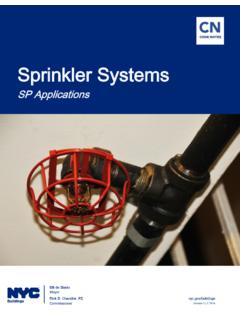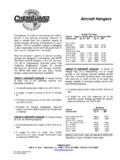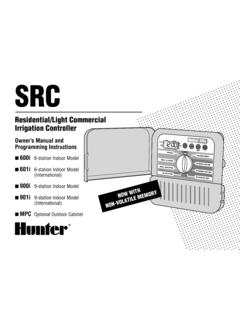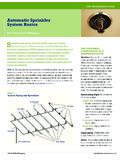Transcription of COMMON MYTHS ABOUT FIRE SPRINKLER …
1 COMMON MYTHS ABOUT fire SPRINKLER PROTECTION Myth Fact "Water damage from a SPRINKLER system will be more extensive than fire damage." Water damage from a SPRINKLER system will be much less severe than the damage caused by water from firefighting hose-lines or smoke and fire damage if the fire goes unabated. Quick response sprinklers release 8 to 24 gallons of water per minute compared to 50 to 125 gallons per minute released by a firehose. Sprinklers are highly reliable devices that are activated by heat. They will only go off if there is a fire which increases the heat beyond the SPRINKLER trigger point (typically 135 to 165 F ( to C)).
2 Preaction systems employ additional safety features. Research has demonstrated that only 1 in 16 million heads ever activates by accident. SPRINKLER systems can be connected to an alarm monitoring company or an external alarm that will notify neighbors or passersby of a water flow. This will facilitate the prompt notification of the fire department and will minimize that amount of water damage. "When a fire occurs, every SPRINKLER head goes off." SPRINKLER heads are individually activated by fire . Residential fires are usually controlled with one SPRINKLER head, and 90 percent of all fires are controlled with six or fewer heads. A study conducted in Australia and New Zealand covering 82 years of automatic SPRINKLER use found that 82 percent of the fires that occurred were controlled by two or fewer sprinklers.
3 "Sprinklers steal water from the fire department hoselines." A properly designed SPRINKLER system (for commercial structures) includes water supplies for the system and fire department hose streams. COMMON MYTHS ABOUT fire SPRINKLER PROTECTION Myth Fact "A smoke detector provides enough protection." Smoke detectors save lives by providing a warning system but can do nothing to extinguish a growing fire or protect those physically unable to escape on their own, such as the elderly or small children. Too often, battery-operated smoke detectors fail to function because the batteries are dead or have been removed.
4 As the percent of homes in America that were "protected" with smoke detectors increased from zero to more than 70 percent, the number of fire deaths in homes did not significantly decrease. "Sprinklers are designed to protect property, but are not effective for life safety." Sprinklers provide a high level of life safety. Statistics demonstrate that there has never been any multiple loss of life in a fully sprinklered building. Property losses are 85 percent less in residences with fire sprinklers compared to those without sprinklers. The combination of automatic sprinklers and early warning systems in all buildings and residences could reduce overall injuries, loss of life, and property damage by at least 50 percent. "The added cost of sprinklers will make housing unaffordable to first-time buyers.
5 "A SPRINKLER system costs one to two percent of the total construction costs. The cost of a SPRINKLER system is comparable to what many people pay for carpet upgrades, a paving stone driveway, or a whirlpool bath. In many communities where SPRINKLER systems are available, consumers are requesting this feature and houses with SPRINKLER systems are selling faster than those without. COMMON MYTHS ABOUT fire SPRINKLER PROTECTION Myth Fact "It is unfair to target new construction because new buildings are safer than older buildings." There are more fires in older buildings because older buildings comprise a larger portion of the country's structural inventory.
6 There are more deaths and injuries in older dwellings because demographically identifiable groups who are more susceptible to fire , such as the elderly and people of low socioeconomic status, tend to live in older homes. Modern construction techniques such as webbed truss construction, vented soffits, and human-made composite materials, make newer houses far more susceptible to serious damage from fire . New structures built today will be older structures tomorrow; it makes sense to start now and use the technology that is available in order to build safer communities. fire is the leading threat to seriously damage or destroy structures; earthquakes, flooding, and other natural disasters lag far behind. "Sprinklers are ugly, I don't want them in my space.
7 " Residential and commercial SPRINKLER heads come in a variety of unobtrusive styles and models and in designer colors. Some can be mounted flush with the ceiling line, and concealed behind protective covers. " SPRINKLER systems are not practical in cold climates, the pipes will freeze and cause water damage." In commercial applications, dry pipe and preaction sprinklers provide an alternative to water-filled pipes. Anchorage, Alaska, has had a residential SPRINKLER ordinance in place for more than 10 years and residents have not experienced a single SPRINKLER system freeze-up. COMMON MYTHS ABOUT fire SPRINKLER PROTECTION Myth Fact Specially molded insulation is available to ensure that piping in unheated attics is properly insulated and protected from freezing.
8 A variety of sidewall SPRINKLER heads are available. Sidewall SPRINKLER piping is placed in the interior walls to prevent exposure to cold attics, and eliminating the concern for freezing. Residential SPRINKLER systems use plastic and copper piping similar to that used for domestic water systems. If the heat in a house drops to a level where the SPRINKLER system will freeze, it is likely that the domestic system will also freeze. There is no unique danger of freezing with SPRINKLER systems that does not already exist with domestic water systems. "Smoke alarms set fire sprinklers off." fire sprinklers and smoke alarm systems are designed to activate according to different conditions. SPRINKLER heads are individually heat activated, usually at 165 F.
9 Smoke alarms, when activated, give only an audible warning sound; they do not cause fire sprinklers to flow water. In commercial applications where flooding volumes are needed to control hazardous areas, preaction and deluge systems may use smoke detection for early notification and operation. "Smoke alarms will put the fire out!" This is a dangerous and misleading statement that is many times made on the basis that smoke alarms will alert the occupants who will then get a fire extinguisher to put out the fire . Untrained persons should only use fire extinguishers to fight small incipient fires. The number-one priority when you hear a smoke alarm or a fire alarm is to get everyone out of the building. COMMON MYTHS ABOUT fire SPRINKLER PROTECTION Myth Fact " fire SPRINKLER systems are not reliable.
10 " Laboratory testing and a 50-year installation/activation history clearly shows that fire SPRINKLER systems exceed a 95 percent "fail-safe" status. "Property will have to pay an expensive yearly testing fee." Like any piece of mechanical equipment, SPRINKLER systems must be inspected, tested, and maintained to ensure a high degree of reliability. No one would buy a car and then never bother to change the oil, tires, or get a tune-up. Testing fees will be directly related to the market demand. "Insurance costs will go up due to fire SPRINKLER system ruptures and leaks." Consider these facts: a) SPRINKLER head failure rate is one in 16 million. b) Domestic plumbing ruptures and leaks are over a 1000 to 1 ratio compared to SPRINKLER system ruptures and leaks. c) If an insurance company wants to place a surcharge on your policy because you have a SPRINKLER system, there are other insurance companies that value the reliability and effectiveness of fire SPRINKLER systems and will reduce your policy premiums if you have fire SPRINKLER protection, especially in rural or "unprotected areas" in our country.









